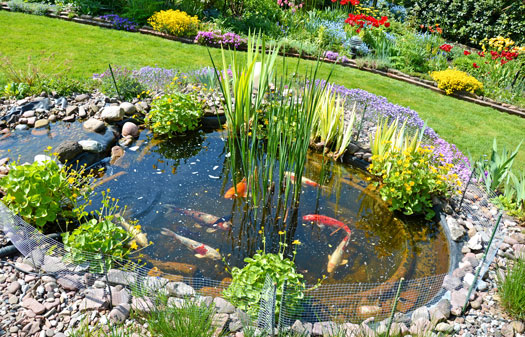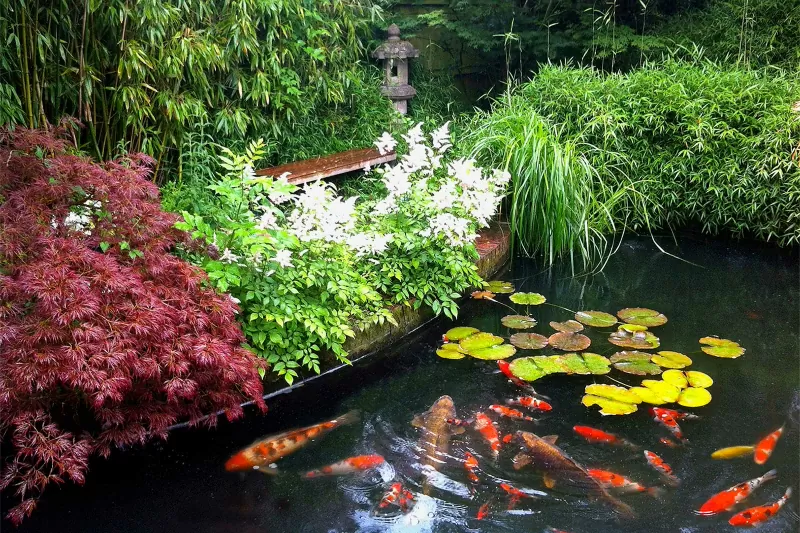Creating a picturesque and thriving aquatic garden in your Koi pond requires careful consideration of plant selection and arrangement. The interplay of aquatic plants and jpn Koi can transform your pond into a serene and harmonious ecosystem. In this guide, we will explore essential tips and recommendations for selecting and arranging aquatic plants to ensure the health and vibrancy of both your plants and your beloved Koi.
Understanding the Koi Pond Ecosystem
Before delving into plant selection, it’s crucial to understand the ecosystem of a Koi pond. Koi, being omnivorous, tend to nibble on plants. Therefore, choosing plants that are both aesthetically pleasing and robust enough to withstand occasional grazing is essential. Additionally, the right balance of sunlight, water depth, and compatible plant varieties is vital for creating a thriving aquatic environment.
Factors to Consider for Plant Selection

Selecting the right aquatic plants for your Koi pond involves considering various factors to ensure a balanced and thriving ecosystem. Here are the key factors to keep in mind when choosing plants for your aquatic garden:
Sunlight Requirements
Different aquatic plants have specific sunlight preferences. Some thrive in full sun, while others prefer partial shade or full shade.
Assess the sunlight conditions in and around your pond throughout the day. Take note of areas that receive direct sunlight and those that remain shaded.
Choose plants that match the sunlight conditions of your pond to ensure optimal growth. For example, water lilies, which require full sun, can be strategically placed in the sunnier areas of the pond.
Water Depth
Aquatic plants exhibit preferences for different water depths. Understanding the depth of your pond is crucial for selecting plants that will thrive in specific areas.
Categorize your pond into zones based on water depth: shallow, middle, and deep. This classification helps in choosing plants that suit each zone’s characteristics.
Marginal plants, like cattails and irises, are well-suited for shallower areas, while submerged plants, such as anacharis, thrive in deeper sections.
Koi Compatibility
Koi are known for their inquisitive nature and may nibble on aquatic plants. It’s essential to select plants that can withstand occasional grazing.
Opt for plants with tougher foliage and those that are less appealing to Koi. Water lettuce and water hyacinth, for instance, have leaves that are unattractive to Koi and provide surface coverage for the pond.
Water Filtration and Oxygenation
Aquatic plants play a vital role in maintaining water quality by absorbing excess nutrients and providing natural filtration.
Consider including a variety of plants that contribute to oxygenation and nutrient absorption. Submerged plants like anacharis and hornwort are excellent choices for enhancing water quality.
Plant Growth and Spread
Some aquatic plants have vigorous growth habits and can spread rapidly, potentially taking over your pond if not managed properly.
Be mindful of the growth habits of the plants you choose. Using containers for certain plants can help control their spread and prevent them from dominating the pond.
Seasonal Changes
Consider the seasonal aspects of plant selection to maintain visual interest throughout the year.
Choose a mix of plants that bloom at different times, ensuring that your pond remains vibrant and attractive during all seasons. This also provides varying levels of shade and cover for Koi throughout the year.
Hardiness and Adaptability
Select plants that are hardy and well-adapted to your local climate. Consider the temperature fluctuations, frost, and other environmental conditions your pond may experience.
Hardy plants are more likely to withstand seasonal changes and offer long-term beauty to your aquatic garden.
Maintenance Requirements
Different plants have varying maintenance needs. Some may require regular pruning, while others are relatively low-maintenance.
Consider your willingness and ability to maintain the garden when selecting plants. Regular monitoring, pruning, and removing dead foliage are essential for a healthy aquatic ecosystem.
Aesthetic Considerations
While functionality is crucial, the aesthetic appeal of your aquatic garden is also significant. Choose plants that complement each other in terms of colour, texture, and form.
Experiment with combinations to create a visually pleasing and harmonious pond. Balance the functional aspects of water filtration and shade provision with the overall beauty of the plants.
Recommended Aquatic Plants for Koi Ponds:

Water Lilies (Nymphaea spp.)
Water lilies are a classic choice for Koi pond builders, providing shade and adding beauty with their exquisite blooms.
Select hardy varieties like ‘Hardy Red’ or ‘Colorado’ that can withstand Koi activity.
Water Hyacinth (Eichhornia crassipes)
Known for their rapid growth and nutrient absorption capabilities, water hyacinths are excellent for maintaining water quality.
Their floating nature makes them less susceptible to Koi nibbling.
Water Lettuce (Pistia stratiotes)
Water lettuce is another floating plant that forms a dense mat, providing shade and reducing sunlight penetration, thereby inhibiting algae growth.
Koi typically avoid water lettuce due to its tougher texture.
Anacharis (Elodea densa)
Anacharis is a popular submerged plant that enhances oxygenation and serves as a refuge for smaller pond inhabitants.
Its dense foliage provides cover for fish and withstands Koi browsing.
Cattails (Typha spp.)
Cattails are excellent marginal plants, thriving in shallow waters along the pond’s edge.
They add vertical interest and create a natural transition between water and land.
Irises (Iris spp.)
Irises are versatile marginal plants that thrive in various water depths.
Their vibrant blooms and sword-like leaves add visual appeal to the pond’s periphery.
Tips for Arranging Aquatic Plants in Koi Ponds
Create Planting Zones
Divide your pond into planting zones based on water depth. This allows you to cater to the specific needs of different plant varieties.
Use Containers for Control
Planting some species in containers prevents them from spreading excessively and provides better control over their growth.
Combine Texture and Color
Create a visually appealing pond by combining plants with different textures and colours. Varied foliage adds depth and interest to the overall design.
Consider Seasonal Changes
Choose a mix of plants that bloom at different times, ensuring year-round visual interest. This also provides varying levels of shade and cover for Koi throughout the seasons.
Monitor and Prune Regularly
Regular maintenance is key to a thriving aquatic garden. Monitor plant growth, remove dead foliage, and prune as needed to maintain a balanced ecosystem.
Introduce Moss and Floating Plants
Mosses and floating plants, such as duckweed, provide additional cover for fish and contribute to a natural, balanced environment.
Balance Aesthetics with Functionality
Strive for a balance between aesthetic appeal and the functionality of the plants in maintaining water quality. A beautiful pond can coexist with a healthy, functional ecosystem.
Conclusion
In conclusion, creating a flourishing aquatic garden in your Koi pond requires thoughtful consideration of plant selection and arrangement. By accounting for factors such as sunlight, water depth, and Koi compatibility, you can design a visually stunning and ecologically balanced pond. The right mix of water lilies, floating plants, submerged vegetation, and marginal plants, strategically arranged, will not only enhance the beauty of your pond but also contribute to the well-being of your Koi and the overall health of the ecosystem. With careful planning and maintenance, Koi Pond builders can make a haven of tranquillity and natural beauty.


